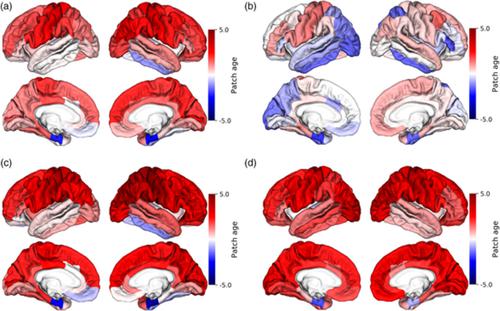当前位置:
X-MOL 学术
›
Hum. Brain Mapp.
›
论文详情
Our official English website, www.x-mol.net, welcomes your
feedback! (Note: you will need to create a separate account there.)
Patch‐wise brain age longitudinal reliability
Human Brain Mapping ( IF 3.5 ) Pub Date : 2020-11-18 , DOI: 10.1002/hbm.25253 Iman Beheshti 1 , Olivier Potvin 1 , Simon Duchesne 1, 2
Human Brain Mapping ( IF 3.5 ) Pub Date : 2020-11-18 , DOI: 10.1002/hbm.25253 Iman Beheshti 1 , Olivier Potvin 1 , Simon Duchesne 1, 2
Affiliation

|
We recently introduced a patch‐wise technique to estimate brain age from anatomical T1‐weighted magnetic resonance imaging (T1w MRI) data. Here, we sought to assess its longitudinal reliability by leveraging a unique dataset of 99 longitudinal MRI scans from a single, cognitively healthy volunteer acquired over a period of 17 years (aged 29–46 years) at multiple sites. We built a robust patch‐wise brain age estimation framework on the basis of 100 cognitively healthy individuals from the MindBoggle dataset (aged 19–61 years) using the Desikan‐Killiany‐Tourville atlas, then applied the model to the volunteer dataset. The results show a high prediction accuracy on the independent test set (R2 = .94, mean absolute error of 0.63 years) and no statistically significant difference between manufacturers, suggesting that the patch‐wise technique has high reliability and can be used for longitudinal multi‐centric studies.
中文翻译:

补丁式脑年龄纵向可靠性
我们最近引入了一种逐块技术,可根据解剖 T1 加权磁共振成像 (T1w MRI) 数据估计大脑年龄。在这里,我们试图通过利用 99 次纵向 MRI 扫描的独特数据集来评估其纵向可靠性,该数据集来自一名在 17 年内(29-46 岁)在多个地点获得的单一认知健康志愿者。我们使用 Desikan-Killiany-Tourville 图集基于 MindBoggle 数据集(19-61 岁)中的 100 名认知健康个体构建了一个强大的逐块大脑年龄估计框架,然后将该模型应用于志愿者数据集。结果表明在独立测试集(R 2 = .94,平均绝对误差为 0.63 年)并且制造商之间没有统计学上的显着差异,表明贴片技术具有高可靠性,可用于纵向多中心研究。
更新日期:2021-01-19
中文翻译:

补丁式脑年龄纵向可靠性
我们最近引入了一种逐块技术,可根据解剖 T1 加权磁共振成像 (T1w MRI) 数据估计大脑年龄。在这里,我们试图通过利用 99 次纵向 MRI 扫描的独特数据集来评估其纵向可靠性,该数据集来自一名在 17 年内(29-46 岁)在多个地点获得的单一认知健康志愿者。我们使用 Desikan-Killiany-Tourville 图集基于 MindBoggle 数据集(19-61 岁)中的 100 名认知健康个体构建了一个强大的逐块大脑年龄估计框架,然后将该模型应用于志愿者数据集。结果表明在独立测试集(R 2 = .94,平均绝对误差为 0.63 年)并且制造商之间没有统计学上的显着差异,表明贴片技术具有高可靠性,可用于纵向多中心研究。










































 京公网安备 11010802027423号
京公网安备 11010802027423号